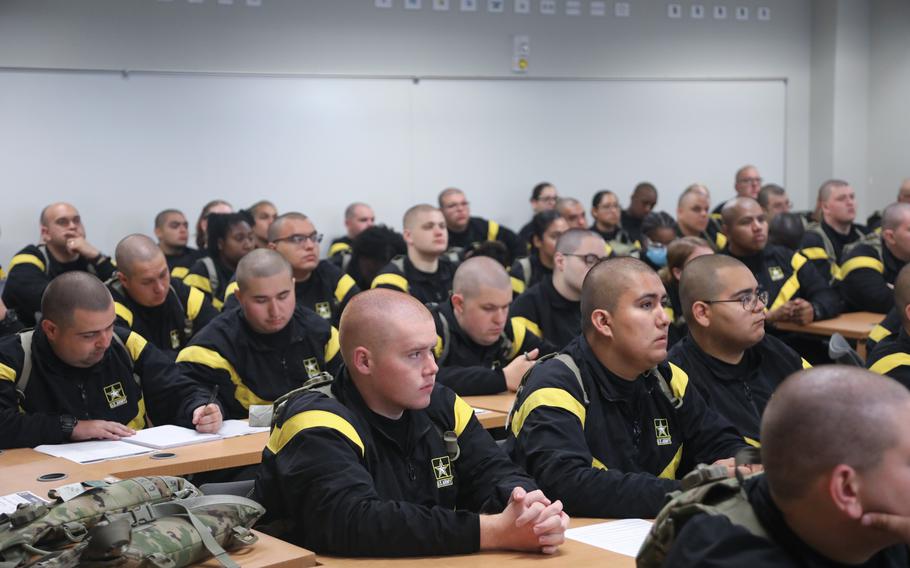
Students in the fitness track of the Army’s Future Soldier Preparatory Course receive resiliency training at Fort Jackson, S.C., on Dec. 13, 2022. The course provides focused academic and fitness instruction for those who have the desire and ability to reach Army standards and serve in the force. (Keion Jackson/U.S. Army)
WASHINGTON — The Army is widening access to its new preparatory course to allow a candidate to enroll in the fitness and academic tracks to help more potential recruits meet the service’s entry requirements.
“Expanding eligibility for the Future Soldier Prep Course is a positive step to providing young Americans the opportunities to overcome obstacles and be all they can be,” said Sgt. Maj. of the Army Michael Grinston, the service’s highest-ranking enlisted officer.
When the Army introduced the course last year as a pilot program to aid recruiting, candidates were allowed to sign up for either the academic or physical fitness track but not both. The idea was to develop them to score higher in one of those areas so they qualify for basic training.
Due to the high rates of success of the pilot program, the Army said it has decided to open the course so recruits can enroll in both tracks — essentially giving them twice the opportunity to make it to basic training.
“The initial results from the Future Soldier Preparatory Course have been promising and have given thousands of young men and women a chance to join our ranks,” said Lt. Gen. Maria Gervais, deputy commanding general of the Army’s Training and Doctrine Command. “This modification to the course is going to increase the quality of individuals entering basic training and provide additional opportunities for our nation’s youth to serve in our all-volunteer force.”
Each track is a weekslong course designed to help recruits meet the Army’s physical and academic enlistment qualifications.
The Army introduced the Future Soldier Prep Course last summer as an effort to increase the size of the recruiting candidate pool. Fewer than 25% of young Americans between the ages of 17 and 24 can meet the academic and physical requirements to join the military, according to recent Pentagon data. Officials have said one of the top obstacles for many is obesity.
“The obesity rate surpasses 20% among kids aged 12 to 19. Test scores on the Armed Service Vocational Aptitude Battery have dropped 9% since the beginning of the COVID-19 pandemic. All-in-all, only 23% of young Americans are fully qualified for entry into the Army,” said Army Brig. Gen. Patrick Michaelis, commanding general at Fort Jackson, S.C. “The Army recognizes that the societal difficulties facing our youth are not going away, so we are going to do something about it ourselves and build the next generation of soldiers.”
Under the Army’s expanded course, dual-enrolled recruits will first take the academic track, and those who complete it will have their body fat measured. Recruits whose body fat is within 2% of the Army standard, which varies based on gender, age, height and weight, will move directly to basic training. Those with body fat that exceeds the 2% mark will begin the fitness improvement track at Fort Jackson.
How high recruits score on the Armed Service Vocational Aptitude Battery — the military-wide standardized entrance test — determines whether they take the academic track at Fort Jackson or Fort Moore, Ga.
“We would be doing a great disservice by turning away motivated applicants who have the noble aim to join the Army but were just not lucky enough to grow up in an environment that could help them achieve their goals,” Michaelis said.
The Army also announced the service will let 100 recruits who have slightly lower entry test scores also enroll in the academic track. Between the start of the course last August and May, roughly 8,500 students have attended and 6,200 have graduated to basic training, the service said.
The Future Soldier Prep Course is one of many efforts the Army has launched in the past year to improve recruiting. Last year, the service missed its recruiting target by about 15,000. This year, it aims to sign up 65,000 new recruits, but top Army officials have already said meeting that goal will be a challenge.
“We are challenged by the fact that a small number of young Americans … are qualified to serve,” Gen. Randy George, vice chief of staff of the Army, told a congressional panel earlier this year. “Fewer still, we’re finding, are interested in serving. And that’s something we are working very hard to change.”
“It took us more than a year to get into the situation that we’re in, in terms of the recruiting landscape, and I think it’s going to take more than a year to turn it around,” Army Secretary Christine Wormuth told reporters in February. “We are in the process of reintroducing the Army to the American public.”
The Army said more changes could still be coming for the service’s evolving prep course, depending on the results out of Fort Jackson and Fort Moore.
“The Army will continue to assess and scale the Future Soldier Preparatory Course to ensure we are successfully preparing and building quality recruits,” the Army said.